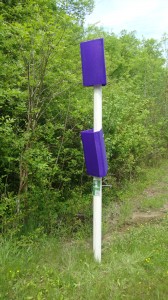The Beetles are Coming!
In this guest blog post, School For Science and Math at Vanderbilt seniors Daniel Mehus, Liza MacPherson, and Valeria Garcia describe the work they are doing to raise awareness about the destructive Emerald Ash Borer invasion that will devastate Nashville’s ash trees. This is the first in a series of posts about the Emerald Ash Borer in Nashville.
The Beatles Are Coming

No, not those Beatles (I wish). These beetles:

This is the Emerald Ash Borer, and this little bug is about to cause an enormous environmental catastrophe in Tennessee. The Emerald Ash Borer is an invasive species of beetle that was introduced to the United States in 2002. This beetle has been responsible for economic loss as well as a loss of tree diversity, practically wiping out the ash tree population in the Great Lakes region.
Treating Trees
Preventative measures are the only successful way to protect ash trees from EABs. Once infected, a tree is essentially doomed. However, there are currently several different methods to treat ash trees to prevent EAB infestation.
Several insecticide options are available to the public. The cost of each option varies depending on the age of the tree and the treatment provided.
Insecticides that can be applied by homeowners are placed the soil around an ash tree. This method is less expensive but known to be less effective.
Other methods require spraying the trunk or injecting the tree with insecticide. These processes must be done by a professional and are more expensive. Application costs are determined by the girth of the tree at a certain height, and may cost as much as hundreds of dollars per tree per year. Insecticide treatments must be repeated every one to two years indefinitely, so the cost to preserve a tree can be significant over time.
The best time to treat ash trees to protect them from EABs would be when the beetles are known to be in the area, but before an infestation occurred. If a tree is already infected or its health is in decline, the odds of saving the tree decrease drastically. Because the EAB was first detected in Davidson County last summer (in 2014), this spring is probably the most effective time for Nashville residents to begin preventative insecticide treatments. Click here for more information about EAB insecticide treatments.
Traps

Currently, there is no effective method of preventing the EAB invasion, so what the SSMV group intends to do is monitor EAB activity levels in Nashville throughout the years. The most feasible way to determine the levels of activity is through the establishment of long term traps.
These large purple traps stand ten feet tall on PVC pipes and have two decks attached with oil lures to attract the beetles. The top tier includes an essential oil that mimics the scent of ash tree leaves, and the lure in the bottom tier imitates the scent of the trunk. These traps do a good job of mimicking ash trees, but the traps themselves will not actually stop the spread of EABs.

The traps are great tools for analyzing the presence of EABs and for tracking the population in a given area, which could be helpful for determining how long to treat the ash trees. These traps will be placed in various areas to track the population of EABs while simultaneously being an educational piece to bring awareness to the EAB problem to citizens who see them. This could potentially help inform citizens on how to save their own ash trees.
Community Partners
Dr. Steve Baskauf works in the Vanderbilt Department of Biological Sciences has had a long-term interest in the ecology invasive species and environmental preservation. Dr. Baskauf has aided this project by providing mentorship on EABs and the effectiveness of the traps. Baskauf is also very concerned about the ash trees on Vanderbilt’s own campus, many of them being an iconic part of campus. Once the trees start blooming, the SSMV Group is planning to help confirm the sex of some of the ash trees on campus to aid in decisions regarding ash tree preservation in Vanderbilt University to preserve both sexes. Click here to go to the Vanderbilt Arboretum EAB information webpage.
Another aspect of this project is aiding Metro Park’s Shelby Bottoms Park in monitoring the anticipated EAB population. Shelby Park is home to beautiful walking trails, the Shelby nature center, sports events, and a significant number of ash trees. However, Shelby faces imminent danger from the inevitable spread of EABs. In an effort to spread awareness about EABs, Shelby has agreed to allow the SSMV Group to place the proposed traps within their park for educational purposes. Though it is not possible to treat all the ash trees within the park, this collaborative effort will prove beneficial to Shelby, the SSMV Group, and the community.
Long Term Goals
Raising awareness about the future EAB infestation in the greater Nashville area is an integral part of the SSMV Group’s project. Many homeowners, businesses, and community leaders are not aware of the danger that their ash trees will face in the near future. Hopefully by initiating an educational platform alongside the scientific use of this project, many ash trees could be saved and the economic impact reduced.
Another goal is to successfully begin long-term monitoring of EAB presence. This could potentially allow for a population density model during an EAB infestation over time. Data of this nature can further the understanding of the behavior of EABs.
Who We Are

We are a group of three students from the School of Science and Math at Vanderbilt (SSMV). Currently, we’re looking to raise awareness about the upcoming Emerald Ash Borer (EAB) invasion in Nashville.
